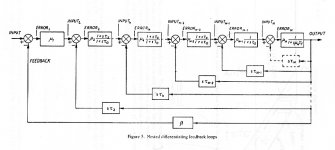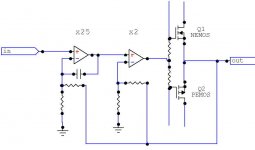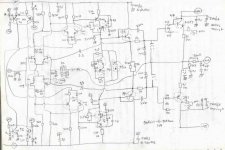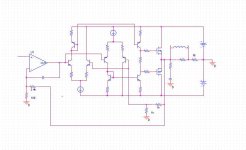john curl said:Actually the feedback question is more complex than expressed here. There is also higher order distortion generated from lower order linearities and FM distortion generated by non-linear input stages within a feedback loop with low open loop bandwidth. Real audio designers take negative feedback very seriously.
There is also higher order distortion generated from lower order linearities...
This is quite a statement.
Can you explain your reasoning?
Tube_Dude said:
You have asked criticism about your design ...I post my opinion about it...if your schematic is good enough for you...that's ok for me...nothing to add.
Tube_Dude,
Thank you for criticism. My reply looks like offensive.
All because my poor english. Can't find rigth words.
Sorry!
rozak said:
Tube_Dude,
Thank you for criticism. My reply looks like offensive.
All because my poor english. Can't find rigth words.
Sorry!
That's ok...my English is also awful .
Have a drink...

Greetings from Norfolk
I have been following the discussion in the thread with great interest, and would now like to add the following
1. No feedback amplifiers – from the discussion it would appear that this is only a true statement when talking about ‘no overall feedback’ amplifiers. Whilst some people may think that they are the last word in design, there is a strong contingent who consider this to be a ‘fad’, caused by the miss use of feedback some years ago. Personally I would concur, as to my mind the correct use of feedback is both essential to a good amplifier design, and bestows a number of inherent advantages to the amplifier (output impedance stability, gain stability, reduction of distortion).
2. With regard to Nested Differential Feedback Loops, as nobody appears to be knowledgeable about them, I shall just have to continue my research.
The example in the thread given by darkfenriz is, to my mind, very trivial, and I have attached a copy of a theoretical concept originally published by E.M. Cherry, back in 1978 in Int. J. Circuit Theory vol. 6 pp. 265 – 288 Title ‘A New Result in Negative Feedback Theory, and its Application to Audio Power Amplifiers’.
It is my opinion that this concept deserves a closer study, and some detailed testing, both theoretical and listening.
3. Whilst I agree that a frequency response to somewhat above the normal audio range (20 kHz) to maintain phase is a good idea, I cannot accept that a response to greater than (say) 200 kHz is necessary.
I cannot think of any source of audio which will produce frequencies of much more than 20 kHz.
As most audio is, today, taken from CDs, the limit of frequency from these cannot be more than 22 kHz for a mono recording (if such exists today) as the sampling frequency is 44 kHz.
Vinyl records will be limited to around 20 kHz due to many factors – ‘needle’ response, cartridge inductance, input cct. shaping, etc.
This leaves magnetic media, and the response from this will be inherently limited by the design of the replay head. Similarly the mini disk.
Radio signals are limited in their frequency range by the transmission requirements – not to occupy too much radio spectrum space.
Also, all commercial media will tend to be audio spectrum limited by the manufacturer or recording studio, as appropriate.
Your further comments would be welcome.
Richard.
I have been following the discussion in the thread with great interest, and would now like to add the following
1. No feedback amplifiers – from the discussion it would appear that this is only a true statement when talking about ‘no overall feedback’ amplifiers. Whilst some people may think that they are the last word in design, there is a strong contingent who consider this to be a ‘fad’, caused by the miss use of feedback some years ago. Personally I would concur, as to my mind the correct use of feedback is both essential to a good amplifier design, and bestows a number of inherent advantages to the amplifier (output impedance stability, gain stability, reduction of distortion).
2. With regard to Nested Differential Feedback Loops, as nobody appears to be knowledgeable about them, I shall just have to continue my research.
The example in the thread given by darkfenriz is, to my mind, very trivial, and I have attached a copy of a theoretical concept originally published by E.M. Cherry, back in 1978 in Int. J. Circuit Theory vol. 6 pp. 265 – 288 Title ‘A New Result in Negative Feedback Theory, and its Application to Audio Power Amplifiers’.
It is my opinion that this concept deserves a closer study, and some detailed testing, both theoretical and listening.
3. Whilst I agree that a frequency response to somewhat above the normal audio range (20 kHz) to maintain phase is a good idea, I cannot accept that a response to greater than (say) 200 kHz is necessary.
I cannot think of any source of audio which will produce frequencies of much more than 20 kHz.
As most audio is, today, taken from CDs, the limit of frequency from these cannot be more than 22 kHz for a mono recording (if such exists today) as the sampling frequency is 44 kHz.
Vinyl records will be limited to around 20 kHz due to many factors – ‘needle’ response, cartridge inductance, input cct. shaping, etc.
This leaves magnetic media, and the response from this will be inherently limited by the design of the replay head. Similarly the mini disk.
Radio signals are limited in their frequency range by the transmission requirements – not to occupy too much radio spectrum space.
Also, all commercial media will tend to be audio spectrum limited by the manufacturer or recording studio, as appropriate.
Your further comments would be welcome.
Richard.
Attachments
Gandalph said:. Whilst I agree that a frequency response to somewhat above the normal audio range (20 kHz) to maintain phase is a good idea, I cannot accept that a response to greater than (say) 200 kHz is necessary.
I cannot think of any source of audio which will produce frequencies of much more than 20 kHz.
I agree to this.
Natural sounds with very fast rise and slope, like a 10 kHz squarewave
does not exist.
Very sharp transients, like when hitting a bottle of glass with a metal stick
still have not at all character close to squarewave rise.
Of what I have read in internet, the air acts as a lowpass filter
and so air has difficulties to act in a very fast rise transient way.
Now, recordings can of course use synthetical sound transients and even high freq squarewaves.
But I do not think loudspeakers and air can reproduce them.
If my amplifiers have an upper freq response of 100 kHz
I do not worry at all.
lumanauw said:Why is that in most feedback amp design, the stability consideration comes the first (and usually the only one)?
Is there any designer that design an amp with exact poles and zero's at frequencies that he wanted (to tailor the "sound") while the stability consideration is not becoming more important than these open-loop curvature?
Maybe this sounds crazy or imposible, but as I see designs of "high-class" amps, they put poles and zero's everywhere in the CCT. I think this "tailored" how the final amp will sound. And to these amps, the stability is no.2 compared to open loop curvature. The drawback of this approach, while the designer can make a "nice sounding" OL curvature, it will be in small bandwith, because it is done after the stability problem fixed.
Hi David,
If you don't use feedback, there is no stability problem. If you don't feed anything back to the input it can not possibly oscillate.
Once you use feedback you need to take care of the stability hence the poles and zeros you see. It's not tailoring how it sounds, it is tailoring to keep it as transparent as possible. The more feedback you try to use, (which means more loop gain) the bigger the chance of oscillation. For oscillation you need at least a gain of one going around the amp when the phase shift is 180 degrees.
The amp gain rolls of with high freq, but if you make high gain to begin with, you can still have enough for oscillation at fairly high freq. So you need all kinds of tricks to keep it stable, while you also want to keep wide bandwidth and high slew rate. Thats why good amps need good designers
Jan Didden
Hi, Gandalph,
Nested feedback amp was very bad experience in my diy life.
The blameless amp was sound for me like super hi end after
this project.
But may be it proves that i can't do it rigth?
Has anybody positive experience with nested?
Hi, Rozak
First of all, I don't understand mathematics of the nested feedback like Gandalph shows above, but if you build something like Darkfenriz shows in post #14, each block has the same frequency bandwith, it is for sure that you are building a "high-order" distortion generator
Post #14 can work (but not surely good sonics) if the first triangle has the widest frequency bandwith, the 2nd narrow-er than the first, the 3rd narrower than the 2nd, so on, decaying.
Even with this decaying mode, the high order artifacts will rise rapidly in the output node.
Better to cascade single triangles with local feedbacks without nested feedback, unless you got a perfect ideal triangles for each triangle.
Natural sounds with very fast rise and slope, like a 10 kHz squarewave does not exist. Very sharp transients, like when hitting a bottle of glass with a metal stick still have not at all character close to squarewave rise.
Actually the fastest Slew rates in music signals are not High Freq sounds, because these are typically low amplitude.
The Higest Slew rate is, I had read ...eons ago... on the sheffield Drum disk, with impulse tight drum notes...
I think the author of that paper had measured a slew rate of 7 volts per Micro second... ( or was that 0.7 ?? !! ?// )

Hi, Janneman,
How are you
Are they putting those poles and zero's just in stability point of view? They are not tailoring the Open Loop curvature / to adjust how the final amp will "sound"?
How are you
The poles and zero's of those amps are in 100's khz or Mhz region. I try to draw it, it makes an OL curvature, but all points are above 20khz. With global feedback applied, I think it will create a pattern of harmonic distortion leftovers within 20khz bandwith (audio).It's not tailoring how it sounds, it is tailoring to keep it as transparent as possible.
Are they putting those poles and zero's just in stability point of view? They are not tailoring the Open Loop curvature / to adjust how the final amp will "sound"?
lumanauw said:
if you build something like Darkfenriz shows in post #14, each block has the same frequency bandwith, it is for sure that you are building a "high-order" distortion generator.
something like this:
Attachments
Going back to the original question about "why". If one is returning to audio interests after a gap of a couple of decades (or fallen through a a hole in the time-space continuum) you could be in for achock. Up to the late '70's a stereo amp claiming (truthfuly) "100W/ch, fla response 20Hz - 20kHz, and less than .1% THD" was a pretty big deal with a pretty big price. Today you can find that by the bushell in AV receuvers at your local chain o discount store. If you can find a copy of Playboy from that era, examine the advertising -- having the right audio gear in your "batchelor pad" was portrayed as an essential "bird" magnet. But alas temus fugit; those days are no more. This state od affairs is a VERY BIG PROBLEM for the marketing department.
While there are still design problems and challenges for amplifiers, they are ones that have little if any impact on the non- or semi- audiophile. Marketing departartments latch on to these (it mnakes no difference whether they understand them or not) and use them as a reason to charge higher prices for fewer units (remember a lot of the old customer base is now happy withy HT-in -a-box and an iPod). Sometimes the ratiuonale and claimed benefits of a particular circuitry configuration are inaccurately described in marketing literature -- but no matter sice to keep the company afloat it is absolutely essential to find something that at least appears to make your product different from everone else.
The result is that you can read a lot of curious theories about what sounds good and why. Personally, I'm somewhat sympathetic of the situation small audio mannufactures face and while I may be skeptical of the BS I recognize that in many cases it is an act of desperation.
While there are still design problems and challenges for amplifiers, they are ones that have little if any impact on the non- or semi- audiophile. Marketing departartments latch on to these (it mnakes no difference whether they understand them or not) and use them as a reason to charge higher prices for fewer units (remember a lot of the old customer base is now happy withy HT-in -a-box and an iPod). Sometimes the ratiuonale and claimed benefits of a particular circuitry configuration are inaccurately described in marketing literature -- but no matter sice to keep the company afloat it is absolutely essential to find something that at least appears to make your product different from everone else.
The result is that you can read a lot of curious theories about what sounds good and why. Personally, I'm somewhat sympathetic of the situation small audio mannufactures face and while I may be skeptical of the BS I recognize that in many cases it is an act of desperation.
sam9 said:Going back to the original question about "why". If one is returning to audio interests after a gap of a couple of decades (or fallen through a a hole in the time-space continuum) you could be in for achock. Up to the late '70's a stereo amp claiming (truthfuly) "100W/ch, fla response 20Hz - 20kHz, and less than .1% THD" was a pretty big deal with a pretty big price. Today you can find that by the bushell in AV receuvers at your local chain o discount store. If you can find a copy of Playboy from that era, examine the advertising -- having the right audio gear in your "batchelor pad" was portrayed as an essential "bird" magnet. But alas temus fugit; those days are no more. This state od affairs is a VERY BIG PROBLEM for the marketing department.
While there are still design problems and challenges for amplifiers, they are ones that have little if any impact on the non- or semi- audiophile. Marketing departartments latch on to these (it mnakes no difference whether they understand them or not) and use them as a reason to charge higher prices for fewer units (remember a lot of the old customer base is now happy withy HT-in -a-box and an iPod). Sometimes the ratiuonale and claimed benefits of a particular circuitry configuration are inaccurately described in marketing literature -- but no matter sice to keep the company afloat it is absolutely essential to find something that at least appears to make your product different from everone else.
The result is that you can read a lot of curious theories about what sounds good and why. Personally, I'm somewhat sympathetic of the situation small audio mannufactures face and while I may be skeptical of the BS I recognize that in many cases it is an act of desperation.
I think you give an accurately and correct description of the situation. The interesting thing is that not only do marketing depts try to sell what they don't understand and what doesn't exists (cannot be confirmed in objective testing), the customer base is only too happy to be duped and tell themselves the same thing the marketing guys tell themselves. Which is why your post will largely be ignored: you rob people of their religion!
Jan Didden
lumanauw said:Hi, Janneman,
How are you
The poles and zero's of those amps are in 100's khz or Mhz region. I try to draw it, it makes an OL curvature, but all points are above 20khz. With global feedback applied, I think it will create a pattern of harmonic distortion leftovers within 20khz bandwith (audio).
Are they putting those poles and zero's just in stability point of view? They are not tailoring the Open Loop curvature / to adjust how the final amp will "sound"?
Hi David,
The well-known "miller cap" often rolls off the open loop gain from a few hundred Herz on down - nothing hf here!
Other than that, you post has a lot of speculation and questions, you are not trying to push us in a specific direction with no facts to back it up, now are you??
Jan Didden
janneman said:
Hi David,
Other than that, you post has a lot of speculation and questions, you are not trying to push us in a specific direction with no facts to back it up, now are you??
Jan Didden
Hi Janneman,
Dont you know the LumanauW is just like
David The Great who killed The massive Goliath..........

K a n w a r
Hi, Janneman,
You are being a redicilous How can a "lumanauw" push something to someone like "janneman"? All I do is :
How can a "lumanauw" push something to someone like "janneman"? All I do is :
If my assumptions is not right, please tell me, so I'm not lost
Why is that so many caps in this schematic? If they are only for stabilization, maybe 1 or 2 is enough. There's 3.3pf. What are they for?
The well-known "miller cap" often rolls off the open loop gain from a few hundred Herz on down - nothing hf here!Herz on down - nothing hf here!
Other than that, you post has a lot of speculation and questions, you are not trying to push us in a specific direction with no facts to back it up, now are you??
You are being a redicilous
questions
If my assumptions is not right, please tell me, so I'm not lost
Why is that so many caps in this schematic? If they are only for stabilization, maybe 1 or 2 is enough. There's 3.3pf. What are they for?
Attachments
lumanauw said:Hi, Rozak,
Did you try putting local C between output node and inverting mode of the 2nd triangle (x2)?
2nd triangle is amp with current mirrors, very stable and
whide band.
No need for C compensation.
Attachments
Workhorse said:
Hi Janneman,
Dont you know the LumanauW is just like
David The Great who killed The massive Goliath..........


K a n w a r
I know, I think he just wants to put us in a black box with no windows
Jan Didden
Hi !
My thoughts/experiences about GNFB... Feedback becomes evil and ruines the sound if not used properly, in this case a "non feedback" amp becomes the better sounding one. The creation of high order harmonics by feedback loop has been proven mathematically in another thread here, and can be reduced. There are some golden rules about using feedback, if these are followed you get a good sounding amp and feedback becomes your friend...
1, stability. not oscillating does not mean the amp is adequately compensated. an undercompensated amp will sound glare and unprecise. (internal ringing/overshooting)
2, "flat" openloop bandwidth, required to avoid the creation of additional high order distortions, this includes "flat" phase response. (no poles in audio freq range)
3, low openloop distortion, high order distortion created in openloop can not be fully compensated by feedback. (unless you have OLBW > 1mhz) They can get even amplified by nfb, especially when undercompensated. Any distortion created openloop will also change the gain and violate No2. Through this, low order distortions will create high order distortions through nfb.
4, linear inputstage, if this comparator does not work correct, feedback gets quite pointless.
5, reactive load must not change openloop gain.
6, low THD at 1khz is pointless if THD at 20khz explodes.
7, Music is not a sinewave, IM will make "all" distortions audible with complex signals. (Folding down HF-content to audio frequency)
No2 automatically results in a high bandwidth amp... I'm not sure about No5, any transconductance output stage would violate that, but there is a highly regarded amp using it. No3 is tough and seems to be the source why GNFB is considered bad. The mechanism for creating high order harmonics through nfb is caused by the unlinear correlation between open loop gain and amount of feedback:
Cg = K / (1 + K/Og)
Cg = resulting closed loop gain
K = gain set by feedback network divider
Og = openloop gain
This mechanism gets reduced for high Og, the formula approximates Cg = K.
8, Use high amounts of feedback without violating No1..3. (The idea behind symasym)
(The idea behind symasym)
Any comments ? Or again thin ice ?
Mike
My thoughts/experiences about GNFB... Feedback becomes evil and ruines the sound if not used properly, in this case a "non feedback" amp becomes the better sounding one. The creation of high order harmonics by feedback loop has been proven mathematically in another thread here, and can be reduced. There are some golden rules about using feedback, if these are followed you get a good sounding amp and feedback becomes your friend...
1, stability. not oscillating does not mean the amp is adequately compensated. an undercompensated amp will sound glare and unprecise. (internal ringing/overshooting)
2, "flat" openloop bandwidth, required to avoid the creation of additional high order distortions, this includes "flat" phase response. (no poles in audio freq range)
3, low openloop distortion, high order distortion created in openloop can not be fully compensated by feedback. (unless you have OLBW > 1mhz) They can get even amplified by nfb, especially when undercompensated. Any distortion created openloop will also change the gain and violate No2. Through this, low order distortions will create high order distortions through nfb.
4, linear inputstage, if this comparator does not work correct, feedback gets quite pointless.
5, reactive load must not change openloop gain.
6, low THD at 1khz is pointless if THD at 20khz explodes.
7, Music is not a sinewave, IM will make "all" distortions audible with complex signals. (Folding down HF-content to audio frequency)
No2 automatically results in a high bandwidth amp... I'm not sure about No5, any transconductance output stage would violate that, but there is a highly regarded amp using it. No3 is tough and seems to be the source why GNFB is considered bad. The mechanism for creating high order harmonics through nfb is caused by the unlinear correlation between open loop gain and amount of feedback:
Cg = K / (1 + K/Og)
Cg = resulting closed loop gain
K = gain set by feedback network divider
Og = openloop gain
This mechanism gets reduced for high Og, the formula approximates Cg = K.
8, Use high amounts of feedback without violating No1..3.
Any comments ? Or again thin ice ?
Mike
- Status
- This old topic is closed. If you want to reopen this topic, contact a moderator using the "Report Post" button.
- Home
- Amplifiers
- Solid State
- A few naive questions



